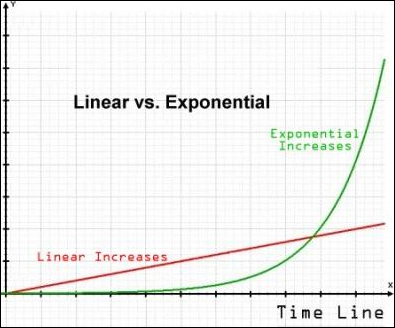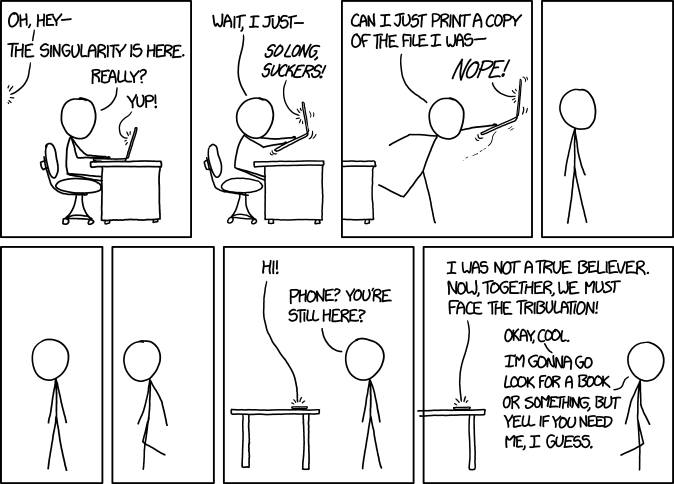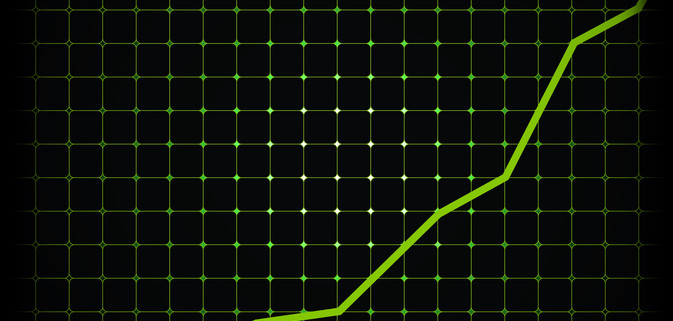What Exponential Innovation Really Means
Last week, we announced a new series on the topic of Exponential Innovation. The piece began with a clear premise, which we restate here:
“The central premise of our series on Exponential Innovation will be this: exponential growth in the complexity of technology, reflected in increasing computing power and capacity, the explosion of data and increasingly complex and powerful material sciences, is a reality in our society, and will have an ever increasing influence over society and the world economy for the foreseeable future.”
Exponential and Linear Innovation
An important part of talking about technological trends is addressing how and why exponential trends differ from linear trends. Why is technological progress exponential, and why does that make such a big difference in how we talk about the future?

It’s common in ordinary speech and thinking to envision most trends as being linear- in part because most of the “trends” we encounter on a daily basis appear to be linear in nature. Linear trends are easy to recognize: the population grows at a more or less steady rate, the price of a liter of milk increases fairly regularly over the years, and one’s age steadily increases.
So we are good at understanding linear trends, but not good at dealing with exponential ones. That’s because evolution has optimized the human brain for dealing with linear functions. These are far more important to our immediate survival than exponential functions are. Worse still, because our brains have been adapted to viewing trends in a linear way, we can very easily make the mistake of assuming that any trend we observe is a linear one.
As Ray Kurzweil put it in his book The Singularity is Near: “the subjective experience is the opposite of the objective reality:” what we experience in a linear fashion subjectively is different from what the data actually says. Because we think in terms of only one or two “steps” on a trend line, trends always appear to us to be more stable than they are.
Thus we predict the future based on an incomplete view of the data- assuming that the current rate of change is going to be continued, without noting that the previous rate of change has been accelerating.

Tim Urban also highlighted this predictive problem in his recent piece on the subject, and produced a helpful graph:
Kurzweil used a concrete example: In 1985, what then comprised the internet had about 2,000 “nodes,” or servers in its network. That was more than double what the number had been only a few years before. If you asked computer specialists in 1985, how fast the internet was likely to grow over the next ten years, you would likely get some function of the past rate of change, projected into the future. If in 1985 there were 2,000 nodes, then we could expect that there would be up to 10,000 nodes by 1985, and perhaps 20,000 by 1995.
In the event, there were millions of nodes by 1995. How could the predictions be so wrong? Well, engineers in 1985 were dealing with the complexity of growing the internet using 1985 technology. But by 1990, new technology had effectively octupled the effectiveness of computers on a cost basis, and the internet had grown exponentially, doubling its own size every few years- rather than growing by 2000 nodes a year, it grew by 4,000, then 8,000, then by 16,000, and so on.
The engineers can be forgiven for seeing that as it concerned them and their work, they did not have the capacity to double the size of the internet in only two years. But because the growing size of the internet also allowed more people and more computer power to be applied to growing it even further, their predictions were based on incomplete assumptions. It would have been very hard indeed to octuple the size of the internet with 1985 technology. But every day that passed, the very same technology was also making that work easier to do.
Imagining An Exponential Future
So we understand that exponential trends make our normal predictive powers pretty weak. So what does your gut tell you about technology in the near future? How do you imagine the world of 2060?
Let’s try a thought experiment: suppose there are 3 Billion smartphones in the world today. Now suppose that all those smartphones have an average computing power of about 2 Gigaflops. An exponential progress curve suggests that within about 45 years from today, a device of the same cost of a modern smartphone should surpass the computing power of all smartphones in the world today. This means that by 2060, every human being should have access to the computing equivalent of the entire world’s personal computers from 2016 combined.
And that level of advancement will actually arrive much sooner than 2060: that year is only the time at which such computing power will be generally available at low cost.
Now, how do you imagine that people will be using that technology in 2060? Will it actually be that we will have smartphones capable of all the computational power of the entire world’s computers, in our pockets? What would we do with all that computational power?
You already can’t keep track of what your own personal computer is doing most of the time- it already does many things of which you are not actively aware. So in a world where all of those processes that are happening today, outside of human observation or awareness, all over the planet, could be happening in a device as small as a smartphone, what would a smartphone actually be used for? In a world of pervasive human-level or superhuman level AI, would it even be necessary to own such a device?
The answer for Kurzweil, and many other futurists, is no. A person would certainly not interact with future technologies in any of the same ways that we currently do. In the same way that we do not operate computers today using punchcards and levers, so too will we stop interacting with computers using keyboards, screens, mouses, or even our voices. At some point in the not too distant future, computers will cease to be treated as mere tools, and will instead become an extension of everything we do and interact with- they will be just another part of us.
The Exponential Is All Around Us
Exponential change is hard to see, because it also takes place over incredibly long time scales. While we can observe exponential trends that are on a human time scale, like the size of the internet, we can’t very well appreciate exponential trends that we are a smaller part of.
Kurzweil makes a compelling argument that the current exponential growth in technology and computing capacity is part of a trend that dates back to almost the beginning of the universe, but has concrete origins in the development of human civilization. The only difference is that we just happening to be living in a time when that trend has started to become a part of our perceptible reality.
Tim Urban, in that same piece on WaitButWhy, asks us to consider the life of a farmer from 1750. If you brought such a person to the world of 2016, what would his reaction to the modern world be? The modern world would be a fantastical, baffling, and overwhelming nightmare. Bright colored capsules that roar down the streets and overhead. Glowing boxes that speak and display images and make sounds, windows of light into other parts of the world, where you can talk to distant people instantaneously. Weapons that can bring the power of the sun to the surface of the world and open gateways to hell.
Would the shock of all that overwhelm him? Would he die from fright?
Next, he asks us to consider the following: if that farmer were to bring someone of a similar remove in history to his own time, taking a peasant from 1500 to the world of 1750, what would that farmer’s reaction be? Surely he would be mightily impressed, but nothing the farmer of 1750 could show that peasant would cause him to die of shock. There would be no apparent magic in anything he saw. Just impressive and exciting new technologies.
The fact is that if exponential innovations in technology continue, then the periods in which such technological changes occur will continue to grow shorter. The world of 2060 may be as shocking to a normal person of 2016, as the world of 2016 would be to a farmer from 1750. And Kurzweil’s contention is that superintelligent AI is the inevitable result of that progress.
Exponential Innovation: Then and Now
In our next post, we’ll discuss the evolution of technology from the distant past to the present, and talk about what technology is capable of doing today. If we’re going to be discussing what technology’s effects will be on society in the near future, it will be important to touch on what we are already capable of doing.
If you’ve got an opinion, please share with us on Twitter, Facebook, or LinkedIn. We will include your reactions in future posts.




